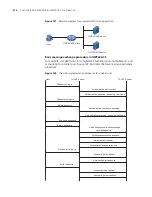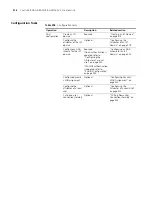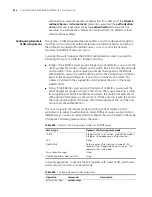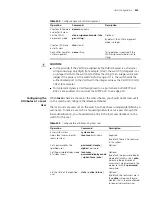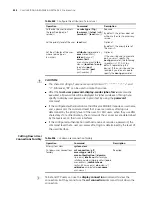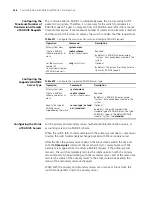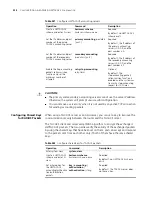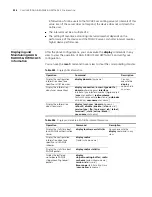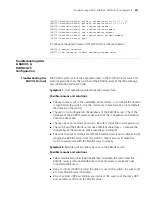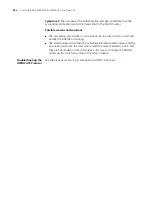
RADIUS Configuration
527
c
CAUTION:
■
In an actual network environment, you can either specify two RADIUS servers
as the primary and secondary accounting servers respectively, or specify only
one server as both the primary and secondary accounting servers. In addition,
because RADIUS adopts different UDP ports to transceive
authentication/authorization packets and the accounting packets, you must set
a port number for accounting different from that set for
authentication/authorization.
■
Stop-accounting requests are critical to billing and will eventually affect the
charges of the users; they are important for both the users and the ISP.
Therefore, the switch should do its best to transmit them to the RADIUS
accounting server. If the RADIUS server does not respond to such a request, the
switch should first buffer the request on itself, and then retransmit the request
to the RADIUS accounting server until it gets a response, or the maximum
number of transmission attempts is reached (in this case, it discards the
request).
■
You can set the maximum number of real-time accounting request attempts in
the case that the accounting fails. If the switch makes all the allowed real-time
accounting request attempts but fails to perform accounting, it cuts down the
connection of the user.
■
The IP address and the port number of the default primary accounting server
“system” are 127.0.0.1 and 1646.
■
Currently, RADIUS does not support the accounting of FTP users.
Configuring Shared Keys
for RADIUS Packets
The RADIUS client and server adopt MD5 algorithm to encrypt the RADIUS packets
exchanged with each other. The two parties verify the validity of the exchanged
packets by using the shared keys that have been set on them, and can accept and
respond to the packets sent from each other only if both of them have the same
shared keys.
c
CAUTION:
You must set the share keys separately for the
authentication/authorization packets and the accounting packets if the
authentication/authorization server and the accounting server are different devices
and the shared keys on the two servers are also different.
Table 410
Configure shared keys for RADIUS packets
Operation Command
Description
Enter system view
system-view
-
Create a RADIUS
scheme and enter its
view
radius scheme
radius-scheme-name
Required
By default, a RADIUS scheme named
“system” has already been created in
the system.
Set a shared key for
the RADIUS
authentication/authori
zation packets
key authentication
string
Required
By default, no shared key is set.
Set a shared key for
the RADIUS
accounting packets
key accounting
string
Required
By default, no shared key is set.
Summary of Contents for Switch 7757
Page 32: ...32 CHAPTER 1 CLI OVERVIEW...
Page 70: ...70 CHAPTER 5 LOGGING IN USING MODEM...
Page 76: ...76 CHAPTER 7 LOGGING IN THROUGH NMS...
Page 86: ...86 CHAPTER 9 CONFIGURATION FILE MANAGEMENT...
Page 120: ...120 CHAPTER 13 ISOLATE USER VLAN CONFIGURATION...
Page 126: ...126 CHAPTER 14 SUPER VLAN...
Page 136: ...136 CHAPTER 16 IP PERFORMANCE CONFIGURATION...
Page 152: ...152 CHAPTER 17 IPX CONFIGURATION...
Page 164: ...164 CHAPTER 19 QINQ CONFIGURATION...
Page 172: ...172 CHAPTER 21 SHARED VLAN CONFIGURATION...
Page 182: ...182 CHAPTER 22 PORT BASIC CONFIGURATION...
Page 198: ...198 CHAPTER 24 PORT ISOLATION CONFIGURATION...
Page 208: ...208 CHAPTER 25 PORT SECURITY CONFIGURATION...
Page 224: ...224 CHAPTER 27 DLDP CONFIGURATION...
Page 232: ...232 CHAPTER 28 MAC ADDRESS TABLE MANAGEMENT...
Page 240: ...240 CHAPTER 29 CENTRALIZED MAC ADDRESS AUTHENTICATION CONFIGURATION...
Page 280: ...280 CHAPTER 30 MSTP CONFIGURATION...
Page 348: ...348 CHAPTER 35 IS IS CONFIGURATION...
Page 408: ...408 CHAPTER 39 802 1X CONFIGURATION...
Page 412: ...412 CHAPTER 40 HABP CONFIGURATION...
Page 422: ...422 CHAPTER 41 MULTICAST OVERVIEW...
Page 426: ...426 CHAPTER 42 GMRP CONFIGURATION...
Page 480: ...480 CHAPTER 47 PIM CONFIGURATION...
Page 506: ...506 CHAPTER 48 MSDP CONFIGURATION...
Page 552: ...552 CHAPTER 51 TRAFFIC ACCOUNTING CONFIGURATION...
Page 570: ...570 CHAPTER 53 HA CONFIGURATION...
Page 582: ...582 CHAPTER 54 ARP CONFIGURATION SwitchA arp protective down recover interval 200...
Page 622: ...622 CHAPTER 58 DHCP RELAY AGENT CONFIGURATION...
Page 684: ...684 CHAPTER 61 QOS CONFIGURATION...
Page 718: ...718 CHAPTER 63 CLUSTER...
Page 738: ...738 CHAPTER 67 UDP HELPER CONFIGURATION...
Page 752: ...752 CHAPTER 69 RMON CONFIGURATION...
Page 772: ...772 CHAPTER 70 NTP CONFIGURATION...
Page 796: ...796 CHAPTER 72 FILE SYSTEM MANAGEMENT...
Page 802: ...802 CHAPTER 73 BIMS CONFIGURATION...
Page 814: ...814 CHAPTER 74 FTP AND TFTP CONFIGURATION...
Page 830: ...830 CHAPTER 75 INFORMATION CENTER...
Page 836: ...836 CHAPTER 76 DNS CONFIGURATION...
Page 852: ...852 CHAPTER 77 BOOTROM AND HOST SOFTWARE LOADING...
Page 858: ...858 CHAPTER 78 BASIC SYSTEM CONFIGURATION DEBUGGING...


